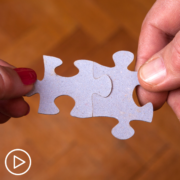Questions and Considerations When Making Myeloma Treatment Decisions
Questions and Considerations When Making Myeloma Treatment Decisions from Patient Empowerment Network on Vimeo.
What should be considered when making a myeloma treatment decision? Expert Dr. Jeffrey Matous discusses key factors involved in choosing therapy and provides a list of questions to ask your doctor to guide optimal care.
Dr. Jeffrey Matous is a myeloma specialist at the Colorado Blood Cancer Institute and the assistant chair in myeloma research for Sarah Cannon Research Institute. Learn more about Dr. Matous.
Related Resources:

|

|

|
Transcript:
Katherine:
What factors impact treatment decisions?
Dr. Jeffrey Matous:
Well, there are so many. One of the key ones is fitness, and fitness is a term that myeloma doctors use and rely on tremendously.
And fitness, more or less, falls into a couple different categories. It’s more complex than that, obviously, but generally speaking, it’s too old or too frail, or young and vigorous and I stress to my patients that vigorous or frail is not determined by chronological age. It’s determined by your physiologic age. That’s really critical, so determining what your patient’s overall fitness is, is really important in myeloma. And then, we have to assess the risk of myeloma. I think we’ll talk about this a little bit later, because not all myeloma is the same and we treat myelomas differently depending on risk, certainly. And then, patient preference is a huge part, because there are so many ways to treat myeloma these days that we explore options with the patients and sometimes patients have pretty strong opinions about, you know, one type of treatment or the other, for example.
Katherine:
What testing should take place following a myeloma diagnosis?
Dr. Jeffrey Matous:
Testing in myeloma is multifaceted, because myeloma can affect patients in so many different ways. For example, it involves radiology studies to look for bone disease, urine work to see if the kidneys are affected by myeloma, a lot of blood work, and then, we also do a lot of testing to make sure that we understand the whole health of the patient, because that comes into play so much when we’re making treatment decisions in myeloma.
Katherine:
What advice do you have for patients and caregivers related to working with their healthcare team in choosing a therapy?
Dr. Jeffrey Matous:
Yeah. I think the big thing is to do some research on your own, but really, ask questions when you see your physician. I mean, ask questions about, for example, what are my treatment options? Are there clinical trials that might be available to me? What’s on the cutting edge in myeloma? What are the standard therapies? What are the pros and cons? And a question I often counsel patients to ask when they’re seeking other opinions is if you had 100 people like me and you treated them this way, how many would do well and how many would not do so well, and prognosis, and so forth. And then, the other thing I think is really important sometimes is gauging how experienced your physician is in treating myeloma, because we actually have data that shows that patients who are treated in myeloma centers actually fair a little better than those who are not.
Involving a myeloma expert in your care doesn’t necessarily mean you have to get your care at that center. It just means you may want a myeloma expert on your team. Pretty much every doctor I know welcomes a myeloma person on their team, because the field is so rapidly evolving. It’s really hard to keep up with for a lot of people.






